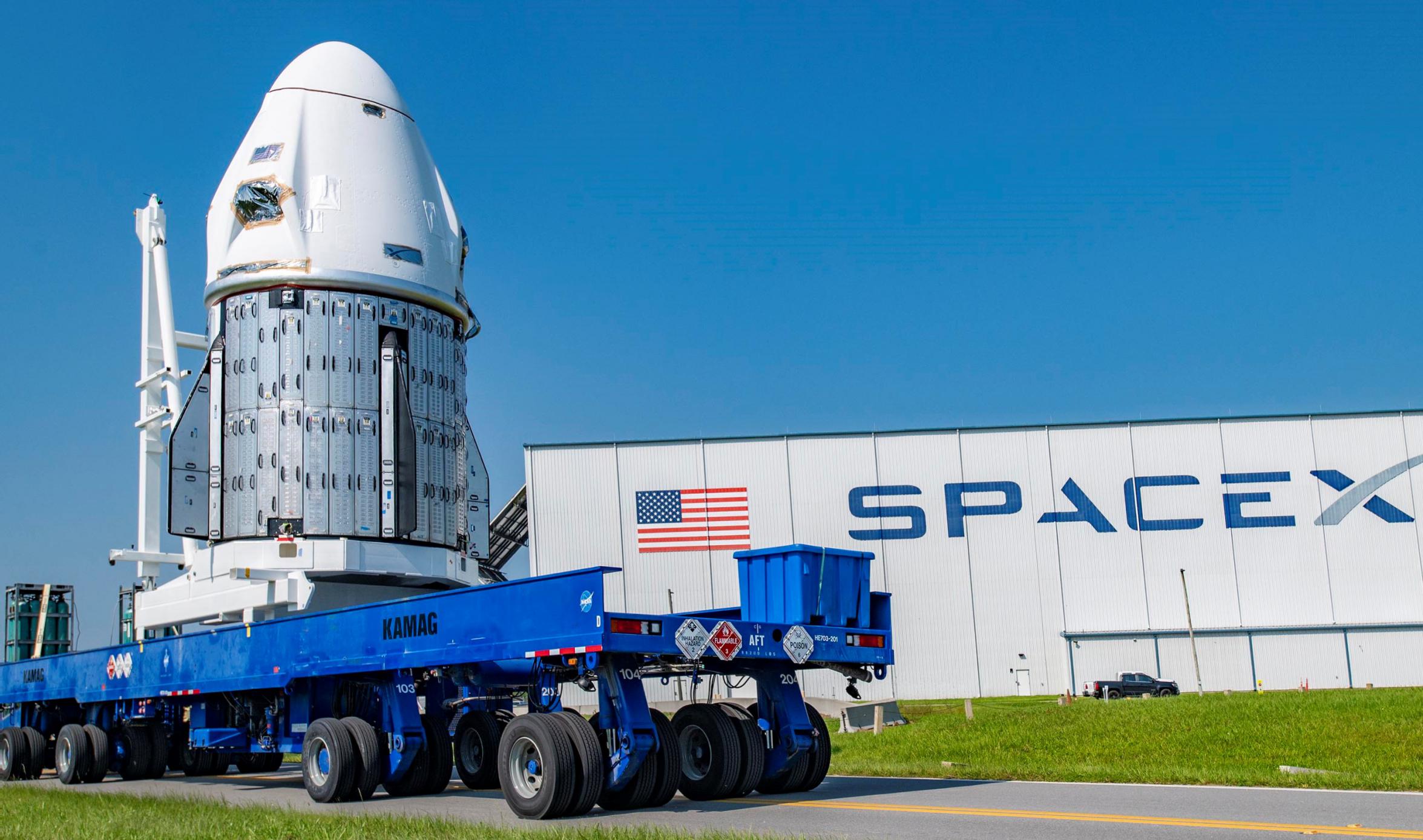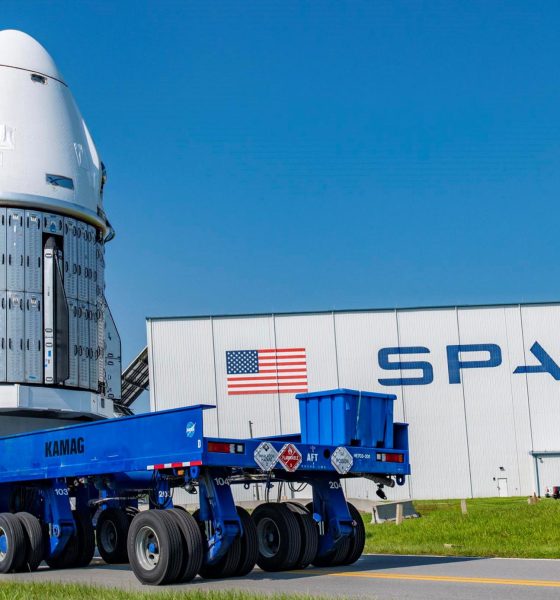

News
Hurricane Ian delays SpaceX’s next NASA astronaut launch
Update: As Hurricane Ian begins to impact Kennedy Space Center, NASA and SpaceX have decided to extend Crew-5’s launch another 24 hours, pushing it to no earlier than (NET) 12:00 pm (16:00 UTC) on Wednesday, October 5th. Both partners will continue to monitor the situation and more delays may follow if the storm causes any relevant damage or flooding.
SpaceX and NASA have decided to delay Crew Dragon’s next astronaut launch from October 3rd to October 4th as Hurricane Ian rapidly approaches Florida’s west coast.
While the hurricane will land on the side of Florida opposite NASA’s Kennedy Space Center launch facilities, where SpaceX leases Pad 39A, it’s still expected to impact parts of the state’s east coast as a tropical storm. In response to forecasts of torrential rain and winds close to 60 mph (~95 km/h) as early as September 28th, NASA has locked down KSC.
The storm had already delayed the arrival of Crew-5’s four astronauts as NASA monitored the increasingly concerning weather system, and is now expected no earlier than (NET) September 30th. That leaves a nominal four days for the crew to run through a busy schedule of preflight testing – including a dry dress rehearsal launch simulation – following NASA’s decision to delay Falcon 9’s Crew-5 launch to 12:23 pm EDT (16:23 UTC) on Tuesday, October 4th.
In a September 26th press conference, NASA and SpaceX officials noted that everything within their control was looking great for the launch. Only two minor issues – one with welds on some of Falcon 9 booster B1077’s COPV pressure vessels and another with a carbon fiber composite joint on Crew-5’s flight-proven Dragon capsule – were still open, and neither was expected to be a problem for the launch.
The mission will ferry NASA astronauts Nicole Mann and Josh Cassada, Japanese (JAXA) astronaut Koichi Wakata, and Russian astronaut Anna Kikina to the International Space Station, where they will spend about five months maintaining the orbital outpost and conducting science. Upon arriving at the ISS, they will take over from astronauts Kjell Lindgren, Bob Hines, Samantha Cristoforetti, and Jessica Watkins, who will board their own Crew Dragon and depart the station five days later.
Attached to a new, expendable ‘trunk,’ the Crew Dragon spacecraft arrived at SpaceX’s Pad 39A processing hangar on September 23rd and was fully integrated with Falcon 9 (an expendable second stage and reusable booster) by September 26th. Falcon 9 booster B1077 will debut on the mission alongside Dragon capsule C210 (Endurance). Dragon C210 splashed down with four astronauts after its first mission, Crew-3, on May 6th, 2022, and will head to orbit a second time 155 days later. Dragon’s turnaround record is 137 days.
Crew-5’s delay – possibly less than 24 hours – pales compared to Hurricane Ian’s other NASA impacts. Most significantly, the agency was forced to roll its first Space Launch System (SLS) Moon rocket back to shelter after playing a risky game of chicken with the storm. The rocket completed its third return to the Vehicle Assembly Building on September 27th, where a few aging or misbehaving components will need to be inspected, modified, or replaced. NASA administrator Bill Nelson anticipates that the rollback will likely delay the SLS rocket’s next launch attempt from early October to mid-November.
However, because NASA is not eager to launch SLS at night, which is where most of its November launch opportunities lie, there’s a good chance that the rocket’s next launch attempt will have to wait until November 22nd or later.

News
Tesla (TSLA) receives “Buy” rating and $551 PT from Canaccord Genuity
He also maintained a “Buy” rating for TSLA stock over the company’s improving long-term outlook, which is driven by autonomy and robotics.

Canaccord Genuity analyst George Gianarikas raised his Tesla (NASDAQ:TSLA) price target from $482 to $551. He also maintained a “Buy” rating for TSLA stock over the company’s improving long-term outlook, which is driven by autonomy and robotics.
The analyst’s updated note
Gianarikas lowered his 4Q25 delivery estimates but pointed to several positive factors in the Tesla story. He noted that EV adoption in emerging markets is gaining pace, and progress in FSD and the Robotaxi rollout in 2026 represent major upside drivers. Further progress in the Optimus program next year could also add more momentum for the electric vehicle maker.
“Overall, yes, 4Q25 delivery expectations are being revised lower. However, the reset in the US EV market is laying the groundwork for a more durable and attractive long-term demand environment.
“At the same time, EV penetration in emerging markets is accelerating, reinforcing Tesla’s potential multi‑year growth runway beyond the US. Global progress in FSD and the anticipated rollout of a larger robotaxi fleet in 2026 are increasingly important components of the Tesla equity story and could provide sentiment tailwinds,” the analyst wrote.
Tesla’s busy 2026
The upcoming year would be a busy one for Tesla, considering the company’s plans and targets. The autonomous two-seat Cybercab has been confirmed to start production sometime in Q2 2026, as per Elon Musk during the 2025 Annual Shareholder Meeting.
Apart from this, Tesla is also expected to unveil the next-generation Roadster on April 1, 2026. Tesla is also expected to start high-volume production of the Tesla Semi in Nevada next year.
Apart from vehicle launches, Tesla has expressed its intentions to significantly ramp the rollout of FSD to several regions worldwide, such as Europe. Plans are also underway to launch more Robotaxi networks in several more key areas across the United States.
News
Waymo sues Santa Monica over order to halt overnight charging sessions
In its complaint, Waymo argued that its self-driving cars’ operations do not constitute a public nuisance, and compliance with the city’s order would cause the company irreparable harm.

Waymo has filed a lawsuit against the City of Santa Monica in Los Angeles County Superior Court, seeking to block an order that requires the company to cease overnight charging at two facilities.
In its complaint, Waymo argued that its self-driving cars’ operations do not constitute a public nuisance, and compliance with the city’s order would cause the company irreparable harm.
Nuisance claims
As noted in a report from the Los Angeles Times, Waymo’s two charging sites at Euclid Street and Broadway have operated for about a year, supporting the company’s growing fleet with round-the-clock activity. Unfortunately, this has also resulted in residents in the area reportedly being unable to sleep due to incessant beeping from self-driving taxis that are moving in and out of the charging stations around the clock.
Frustrated residents have protested against the Waymos by blocking the vehicles’ paths, placing cones, and “stacking” cars to create backups. This has also resulted in multiple calls to the police.
Last month, the city issued an order to Waymo and its charging partner, Voltera, to cease overnight operations at the charging locations, stating that the self-driving vehicles’ activities at night were a public nuisance. A December 15 meeting yielded no agreement on mitigations like software rerouting. Waymo proposed changes, but the city reportedly insisted that nothing would satisfy the irate residents.
“We are disappointed that the City has chosen an adversarial path over a collaborative one. The City’s position has been to insist that no actions taken or proposed by Waymo would satisfy the complaining neighbors and therefore must be deemed insufficient,” a Waymo spokesperson stated.
Waymo pushes back
In its legal complaint, Waymo stated that its “activities at the Broadway Facilities do not constitute a public nuisance.” The company also noted that it “faces imminent and irreparable harm to its operations, employees, and customers” from the city’s order. The suit also stated that the city was fully aware that the Voltera charging sites would be operating around the clock to support Waymo’s self-driving taxis.
The company highlighted over one million trips in Santa Monica since launch, with more than 50,000 rides starting or ending there in November alone. Waymo also criticized the city for adopting a contentious strategy against businesses.
“The City of Santa Monica’s recent actions are inconsistent with its stated goal of attracting investment. At a time when the City faces a serious fiscal crisis, officials are choosing to obstruct properly permitted investment rather than fostering a ‘ready for business’ environment,” Waymo stated.
News
Tesla FSD v14.2.2 is getting rave reviews from drivers
So far, early testers have reported buttery-smooth drives with confident performance, even at night or on twisty roads.

Tesla Full Self-Driving (Supervised) v14.2.2 is receiving positive reviews from owners, with several drivers praising the build’s lack of hesitation during lane changes and its smoother decision-making, among others.
The update, which started rolling out on Monday, also adds features like dynamic arrival pin adjustment. So far, early testers have reported buttery-smooth drives with confident performance, even at night or on twisty roads.
Owners highlight major improvements
Longtime Tesla owner and FSD user @BLKMDL3 shared a detailed 10-hour impression of FSD v14.2.2, noting that the system exhibited “zero lane change hesitation” and “extremely refined” lane choices. He praised Mad Max mode’s performance, stellar parking in locations including ticket dispensers, and impressive canyon runs even in dark conditions.
Fellow FSD user Dan Burkland reported an hour of FSD v14.2.2’s nighttime driving with “zero hesitations” and “buttery smooth” confidence reminiscent of Robotaxi rides in areas such as Austin, Texas. Veteran FSD user Whole Mars Catalog also demonstrated voice navigation via Grok, while Tesla owner Devin Olsen completed a nearly two-hour drive with FSD v14.2.2 in heavy traffic and rain with strong performance.
Closer to unsupervised
FSD has been receiving rave reviews, even from Tesla’s competitors. Xpeng CEO He Xiaopeng, for one, offered fresh praise for FSD v14.2 after visiting Silicon Valley. Following extended test drives of Tesla vehicles running the latest FSD software, He stated that the system has made major strides, reinforcing his view that Tesla’s approach to autonomy is indeed the proper path towards autonomy.
According to He, Tesla’s FSD has evolved from a smooth Level 2 advanced driver assistance system into what he described as a “near-Level 4” experience in terms of capabilities. While acknowledging that areas of improvement are still present, the Xpeng CEO stated that FSD’s current iteration significantly surpasses last year’s capabilities. He also reiterated his belief that Tesla’s strategy of using the same autonomous software and hardware architecture across private vehicles and robotaxis is the right long-term approach, as it would allow users to bypass intermediate autonomy stages and move closer to Level 4 functionality.








